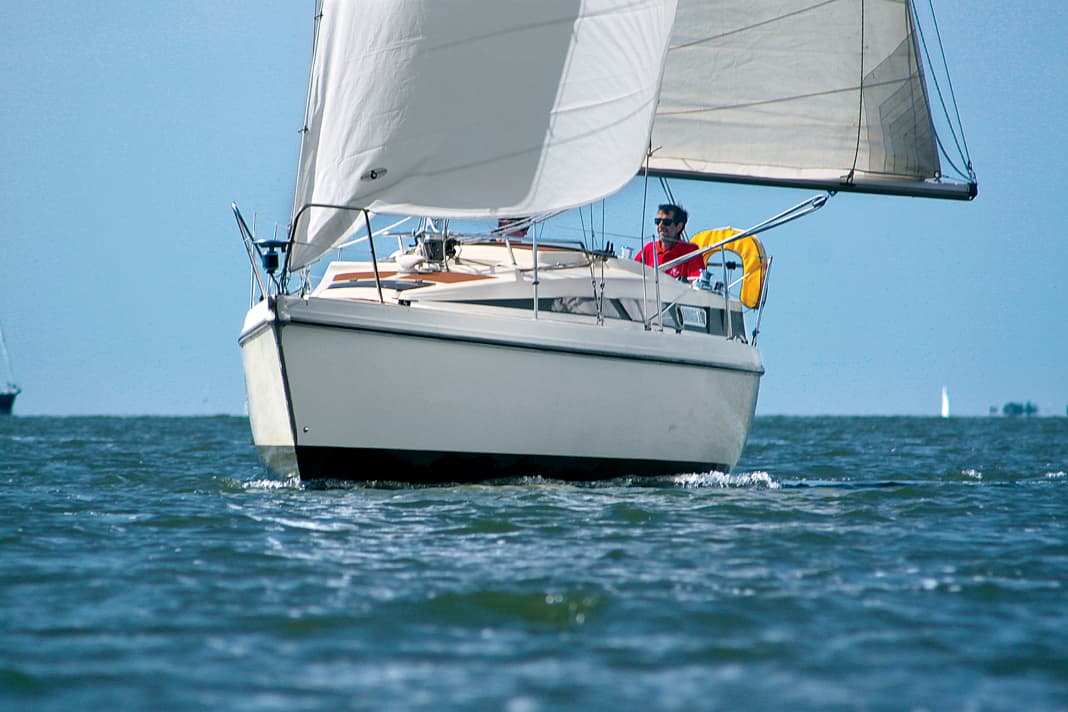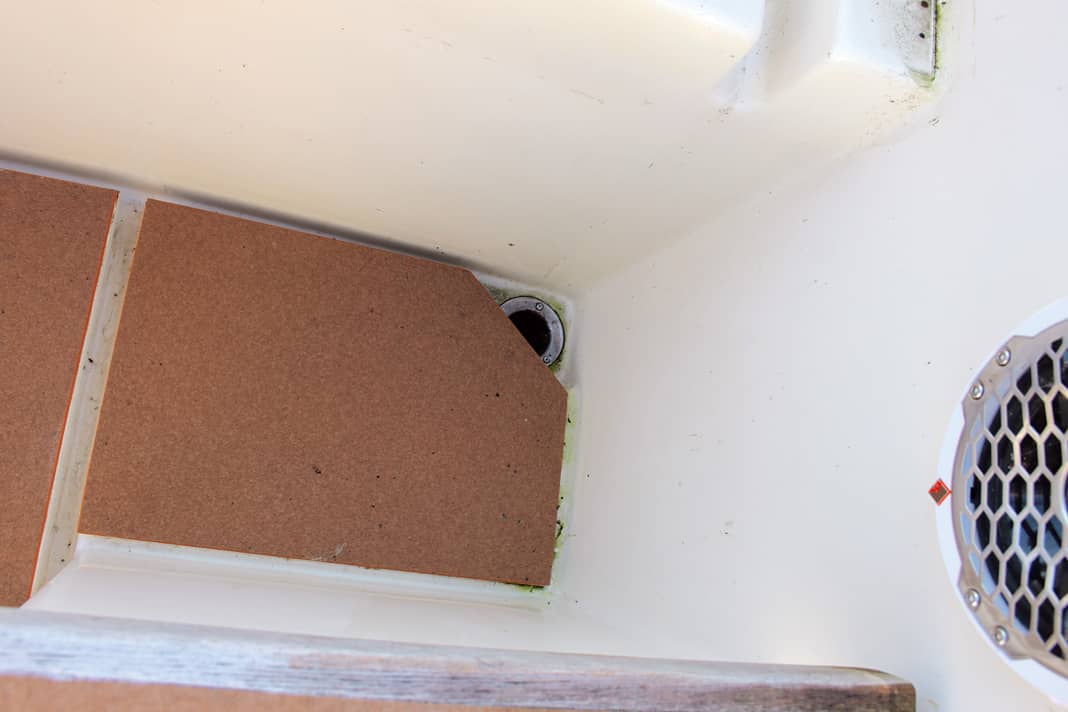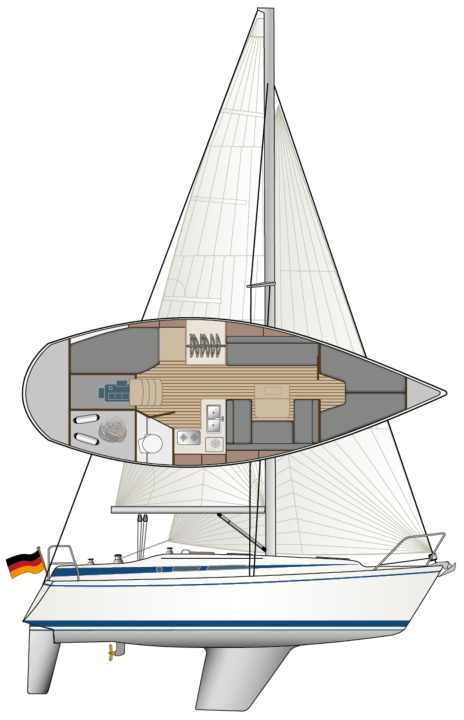Bavaria 890: A former flagship from the early days of the shipyard in a used boat test
Alexander Worms
· 15.03.2024






Yes, the eighties - those were the days. A young shipyard from Bavaria wrote in all seriousness in the brochure for the new flagship with a view of the lavishly equipped cabin: "Bavaria 890, the comfort yacht." So far, so good. But then: "So you can mix yourself a stiff drink even when the wind is blowing." What would be impossible today was obviously in keeping with the spirit of the times.
After all, this then small shipyard turned 45 last year and has become one of the largest of its kind in the world in over four decades. The 890 has contributed to this to some extent. Even the shipyard can no longer say how many were built, only the time period is known: They started at boot Düsseldorf 1981 and finished again in 1984. During this time, between 100 and 200 units were built.
The 890 is a real yacht. Thanks to its high freeboard and sheltered cockpit, the ship conveys a feeling of security, even below deck. Mahogany panelling and originally dark upholstery fabrics as well as small cabin windows give the saloon the cellar feeling that was once so popular. Of course, because the shipyard from Giebelstadt was modelled on none other than the Finns with their Swans, which they also wanted to emulate in terms of solidity. A fully laminated hull-deck transition, for example, and a whopping 44 per cent ballast ratio are proof of this.
Bavaria 890 offers cosy variety
In the cabin, sailors enjoy comfortable seating at the large table. The table is height-adjustable and can make the berth in the saloon 1.10 metres wide, making it ideal as a sea berth - but only for people who are no taller than 1.80 metres, as the length is only 1.90 metres. Incidentally, this applies to all berths and the headroom on the 890. As Germans grow an average of 1.5 centimetres taller every decade, this was fine at the time, but from today's perspective, the berth lengths are tight. According to the shipyard brochure, the forward berths are 2.05 metres long - this could not be confirmed on the test ship. In the 1982 YACHT test, a version with a different layout had to be tested. At that time, the toilet room, which could be closed on both sides with sliding doors, was located between the saloon and the foredeck. The galley on the starboard side next to the companionway was located where the small toilet room without washbasin is located on the test boat.
Good: The fact that the interior fittings in the layout with a separate toilet room were moved forward by around half a metre created space for an oil locker in the saloon. Which of the two layouts is more favourable is left to personal taste. However, the desire for a separate toilet room was already recognisable at the time.
Room for variance in the drive
The diversity of variants is also evident in the drive system. The original brochure mentions a Volvo diesel with 18 hp and saildrive. In the test boat, a Faryman on a shaft did the job; according to the owner, this was also original equipment. As is always the case with older engines: after almost 40 years, the end of its life is in sight and a new investment is imminent. The engine compartment is large and accessible through a hatch in the cockpit floor, providing space for more expansive engines. A shaft drive is more flexible when it comes to replacement, as special adapters are not required; this means you are less restricted in your choice of make.
If a saildrive is installed, it is important to check the age of the diaphragm and the condition of the oil in the drive. If there is a whitish discolouration, there is a risk of worn oil seals.
More sailing horsepower with inland rigging
Finally, the cloths glide up the mast. This is the inland rig, as the ship originally comes from Lake Constance. And how does a young shipyard turn a normal rig into an inland rig without having to buy a larger mast? Firstly, the attachment point of the forestay is moved from 7/8 to the top of the mast and that of the boom downwards - immediately creating more sail area. However, the boom is now almost dangerously low. With every tack or jibe, you have to pull your head in and a sprayhood is hardly possible any more.
Surely, in co-operation with a sailmaker, the chine can be raised, which solves the problem. So the inland rig does not have to be a knock-out criterion. However, it should be borne in mind that the additional square metres will certainly help the boat, because the Bavaria is fun downwind in 8 knots of wind. The new genoa sails well, and the old main with its blown-out profile also pushes satisfactorily in this weather. Now the Bavaria is playing to a strength that one would not necessarily attribute to her: she sails with exceptional agility.
Turning angles of around 80 degrees at speeds of around 4.5 knots are excellent values given the conditions. The high ballast ratio is not so noticeable. But even in stronger winds, the owner assures us, the Bavaria behaves like a much larger yacht.
The 890 also benefits from the fact that Axel Mohnhaupt, a designer with experience from America's Cup campaigns and a fluid mechanic, knows what makes a hull fast: very light rudder pressure, very sensitive on the wind edge and almost a little nervous on the rudder. You wouldn't have expected such light-footedness. Incidentally, in 1982, our colleagues found that the 890 was not stable enough for a cruising yacht and recommended retrofitting in this respect.
Spoilt for choice
If you really want a version with a steering wheel, you can also find one on the 890. But with compromises: The distance between the aft bench in the cockpit and the wheel is too small, so the helmsman cannot steer standing up. The wheel is too small to indicate the direction from the coaming, and sitting on the completely flat aft bench is also not recommended. In addition, much of the sensitivity at the rudder is lost due to the deflections. Therefore the better choice: the tiller.
However, their use requires good organisation in the cockpit. The mainsheet runs on the traveller on the bridge deck; a well-coordinated crew could swap the roles on the lines, as the helmsman has easy access to the foresheet. The thwarts are a little too short to lie on, as there is a piece missing aft on both sides of the helm, where the helmsman should obviously stand when piloting.
The storage options are well designed: There are huge storage spaces both to starboard and in the stern, although these require a false floor, as on the test boat, if you don't always want to dive upside down for lines and fenders. Another great feature is the space for the life raft in the cockpit. They were ahead of their time.
Advantages and disadvantages of the Bavaria 890
The Bavaria 890 is a compact yacht that is safe and fun to sail. It is also robustly built, with not a single hairline crack in the gelcoat on the test boat. The colour choice of the early eighties is strange, the test boat is beige with black trim. But this can be changed using film or paint.
The Bavaria can offer a lot for two sailors, even on longer journeys, thanks to the enormous amount of storage space and large tanks for water and diesel. However, a test berth should be used to find out whether the berth in the foredeck is large enough, as it does not meet today's minimum standard in terms of both length and width.
Also to be considered: In the popular price category, boats with a separate aft cabin and a real wet room, such as the Etap 28i (Test in YACHT 17/2017), Dehler 31 (YACHT 18/2013) or Elan 331, which are also well built. And spare parts are still readily available for at least the first two.
Before buying, be sure to check the cockpit/deck panelling; replacing it requires either skill and time or a major investment. The ceiling panelling in the cabin is another such point. Otherwise, there is nothing to be said against the 890.
Bavarian boat building: What to look out for when buying






The Bavaria 890 is solidly built. Nevertheless, it is important to pay attention to any expensive details when buying.
Floor covering
The original teak covering on the cockpit floor and dents has not survived three decades. There are more or less good alternatives on almost all used 890s.
Rudder bearing
At least the upper bearing was clearly worn out on the test boat, resulting in vibration in the rudder. It is easy to replace if the boat is dry. The bearings are turned plastic parts and as such are also available without a spare parts supply.
Build-up window
A perennial favourite with used boats are the superstructure windows - usually made of Plexiglas, they become brittle and have to be replaced. This is more difficult than many people think if it is to be tight and not crack. Good: The surfaces on the 890 are small, which makes replacement easier.
Bow fitting
The bow fitting is a cast aluminium part. The material is brittle, and this one was damaged in a collision. A replacement is not available or would have to be laboriously milled; it is very difficult to repair when installed. In this case, alternatives for an anchor roller must be considered.
Ceiling panelling
The glued inside of the cabin roof has come loose over the years. Shreds of PVC/velour then hang from the ceiling. Replacement is possible, but requires a certain amount of skill. On the test boat, this was done by a shipyard - the result is good, but also expensive, as removing the old adhesive in particular takes a lot of time.
The Bavaria 890 in detail

Technical data of the Bavaria 890
- Torso length: 8,94 m
- Width: 2,95 m
- Draught/alternative: 1,65/1,20 m
- Weight: 3,2 t
- Ballast/proportion: 1,4 t/44 %
- sail area: 39,0 m2
- Machine (Faryman): 13 kW/18 hp
Hull and deck construction
Hull/deck in sandwich, hand lay-up method with iso-resins. Stressed areas solid
Price and shipyard
- Base price ex shipyard 1982: 43.000 €
- Used boat price: 16-30.000 €
Status 03/2024
YACHT review of the Bavaria 890
A successful compromise between sailing characteristics and space. The 890 is a sensible introduction to yacht sailing for two
Design and concept
- + High ballast content
- - Standing heights and bunk lengths short
Sailing performance and trim
- + Very good performance on the cross
- - Deep large tree
Living and finishing quality
- + Oil tool cabinet
- - Small WC room
Equipment and technology
- + Large tanks
- - Operability of WC seacocks
The article first appeared in YACHT 21/2017 and has been updated for the online version.
More used boat tests:
- Winner 10.10: Popular second-hand boat is suitable as an agile family runabout
- Grinde used boat test: Modern GRP classic is made for strong winds
- Hornet 32: High-quality cruising boat from the Elbe in a used boat test
- Biga 24: Beautiful, fast and complete, even as a used boat
- Hallberg-Rassy 342: Popular used boat offers the usual quality

